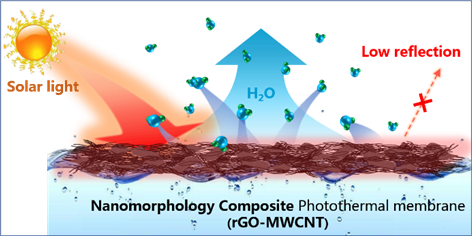
Water shortage is a global issue facing mankind. Natural solar-driven water evaporation process suffers from low efficiency because water is a poor light absorber.
Photothermal membrane, which is able to realize efficient light harvesting and conversion to heat, is an ideal choice to accelerate water evaporation under illumination. However, the tedious process and special techniques in surface modification limit the further development in widespread application.
Recently, a research team led by Prof. JIANG Heqing from Qingdao Key Laboratory of Functional Membrane Material and Membrane Technology of Qingdao Institute of Bioenergy and Bioprocess Technology (QIBEBT) of the Chinese Academy of Sciences developed a facile and general "Nanomorphology Composite" strategy to fabricate the carbon-based photothermal membrane with controllable surface microstructure using one-dimensional (1D) carbon nanotubes (CNT) and two-dimensional (2D) graphene.

Figure A. Photothermal evaporation improved by composite membrane following the "Nanomorphology Composite" strategy. (Image by WANG Yuchao)
Comparing with the single-component photothermal membrane, the composited membrane exhibited a higher surface roughness for better solar harvesting, which resulted in a higher surface temperature.
The water evaporation rate of optimized composited membrane reached up to 1.22 kg m-2 h-1, about 180 % higher than that of natural evaporation under illumination. Additionally, the rationally designed composite photothermal membrane could be easily loaded on various substrates to meet different water conditions in practical application.
It is believed that the rationally designed membrane via cost-effective and easy-to-handle approach was potentially to be used in solar-driven water desalination and wastewater treatment especially in point-of-use front.
The related work was published in Journal of Materials Chemistry A.
This study was funded by the National Natural Science Foundation of China, Shandong Provincial Natural Science Foundation, Shandong Provincial Key R&D Project, and Qingdao Public Health and Science and Technology Plan.

86-10-68597521 (day)
86-10-68597289 (night)

86-10-68511095 (day)
86-10-68512458 (night)

cas_en@cas.cn

52 Sanlihe Rd., Xicheng District,
Beijing, China (100864)

